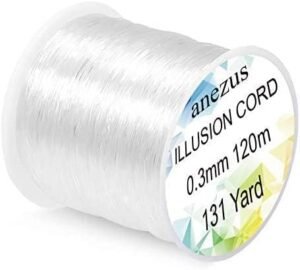The Ultimate Guide to the Best Monofilament Fishing Line
Finding the best monofilament fishing line is important for anglers who don’t want to lose the big one. The wrong choice can make all the difference between landing that trophy-size catch or your typical outcome. Loser!
A robust monofilament line ensures it can handle intense fighting scenarios when hooked onto formidable game fish without compromising performance or snapping under pressure. An equally significant consideration is knot strength and the ease of tying knots.
The best monofilament fishing line should exhibit exceptional knot strength, allowing anglers to confidently tie different knots without worrying about them slipping or breaking during critical moments. This is crucial because a weak knot can result in lost fish and shattered dreams.
Another vital factor to consider when selecting a monofilament fishing line is its diameter and visibility. Opting for a thin-diameter line enables longer casting distances and ensures reduced water drag, enabling lures to swim more naturally.
Furthermore, choosing a line with low visibility underwater increases the chances of fooling fish into biting, enhancing angler success rates. With these factors in mind, investing time in researching and choosing the best monofilament fishing line suited to individual angling needs becomes imperative for any angler aiming to maximize their chances of success on the water.
What is Monofilament Fishing Line?
Monofilament fishing lines are typically made from a single strand of nylon or other similar polymeric materials. The manufacturing process involves extruding the material into a circular cross-section, producing a smooth and uniform line. The composition may vary among manufacturers, with some incorporating additives to enhance specific properties like strength, knot retention, or UV resistance.
Moreover, the diameter of monofilament lines can vary greatly depending on the intended use and pound test rating. Thinner diameters are desirable for increased sensitivity and improved casting distance.
Pros and Cons
Monofilament fishing lines offer several advantages over other types, such as braided or fluorocarbon lines. One significant advantage is their superior knot strength, making them easier to tie and ensuring secure connections between the line and hooks or lures. Additionally, monofilament lines have a certain level of stretchability that aids in absorbing sudden shocks from aggressive fish strikes, reducing the risk of line breakage.
Another benefit is their affordability compared to more specialized alternatives. However, like any fishing line type, monofilament has its limitations. One notable disadvantage is its relatively higher visibility underwater compared to fluorocarbon lines. This becomes particularly relevant in clear water conditions where fish may become wary of visible lines, leading to decreased catch rates.
Moreover, monofilaments can absorb water over time, affecting their buoyancy properties – something anglers need to consider when targeting specific species at different depths. Understanding the composition and construction of monofilament fishing lines allows anglers to make informed choices based on desired characteristics such as strength or sensitivity.
While they have numerous advantages, including superior knot retention and affordability, it’s important to acknowledge their limitations regarding visibility underwater and potential water absorption over time. By weighing these factors against specific fishing conditions and target species, anglers can select the best monofilament fishing line for their needs.
Choosing the Best Monofilament Fishing Line
Strength and Durability
When selecting the best monofilament fishing line, strength and durability are crucial. One of the primary indicators of a line’s strength is its pound test rating, which refers to the amount of weight the line can handle before breaking.
Choosing a monofilament line with a suitable pound test rating is important based on your target fish species and fishing conditions. A higher pound test rating signifies greater strength and resistance to breaking under pressure.
Additionally, consider the line’s abrasion resistance properties, as it determines how well it can withstand rough conditions such as rocks, submerged branches, or sharp teeth. Opting for a monofilament line that exhibits excellent abrasion resistance will ensure longevity and reliability.
Furthermore, prolonged exposure to sunlight can have detrimental effects on monofilament lines. UV rays from the sun can weaken and degrade them over time, leading to reduced strength and durability.
Therefore, choosing a monofilament fishing line that offers UV-resistance properties is essential. This feature will protect against the harmful effects of sunlight exposure, extending the lifespan of your fishing line.
Knot Strength and Ease of Tying Knots
Another vital aspect when choosing a monofilament fishing line is its knot strength and ease of tying knots. The reliability of knots is crucial since they secure hooks, swivels, or lures onto the fishing line. Different types of knots are suitable for monofilament lines; examples include popular options like improved clinch knot or Palomar knot.
However, not all lines hold knots equally well; some may slip or weaken when subjected to pressure. To ensure optimal knot performance with your selected monofilament line, it is advisable to experiment with various tying techniques until you find one that holds securely.
Testing knot strength using different methods, such as a knot strength tester or applying gradual pressure during routine fishing activities, can also help gauge the line’s reliability. Ultimately, opting for a monofilament line that exhibits high knot strength and is easy to tie will provide peace of mind and reduce the risk of losing prized catches.
Diameter and Visibility
Regarding monofilament fishing lines, diameter plays a significant role in casting distance and fish visibility. Selecting a line with a thin diameter offers several advantages.
Firstly, thinner lines create less drag when casting, allowing for increased distance and accuracy. This characteristic is particularly advantageous when targeting fish in larger bodies of water or when making long-distance casts.
Moreover, the visibility of the fishing line underwater can greatly impact its effectiveness in fooling fish. Opting for a monofilament line with low visibility characteristics will reduce the chances of scaring off cautious fish species.
Transparent or lightly colored lines blend better with the surrounding water environment, making them less noticeable to fish. Carefully considering diameter and visibility factors will assist in selecting the best monofilament fishing line that caters to your specific angling needs effectively.
The Best Monofilament Fishing Line
Standard Monofilament Lines
Standard monofilament lines have been a go-to choice for anglers for decades. These lines are known for their versatility, reliability, and affordability.
Several well-established brands stand out with exceptional features and performance regarding standard monofilament lines. Berkley Trilene XL: This line is highly regarded among fishing enthusiasts due to its smooth casting capabilities, allowing for effortless long-distance casts.
Its high knot strength ensures secure connections with your tackle, reducing the risk of losing that prized catch. The Berkley Trilene XL’s excellent manageability and controlled stretch make it an ideal choice for various fishing techniques.
Stren Original: Renowned for its superior shock resistance, the Stren Original monofilament line excels when faced with sudden strikes or aggressive fish. This line’s ability to absorb energy without snapping gives anglers confidence in challenging situations.
Additionally, it maintains its strength while handling heavy loads, making it ideal for targeting larger game fish. P-Line CXX X-Tra Strong: If you’re fishing where abrasion resistance is crucial, the P-Line CXX X-Tra Strong should be your top consideration.
This line boasts exceptional durability and toughness against rough underwater structures such as rocks or submerged vegetation. With its superior abrasion resistance properties and high knot strength, this monofilament ensures reliable performance even in demanding environments.
Superior Monofilament Lines
Fluorocarbon Coated Monofilaments
Fluorocarbon-coated monofilaments offer the best of both worlds by combining the advantages of traditional monofilaments with the added benefits of fluorocarbon technology. Seaguar Red Label: Designed with low visibility in mind, the Seaguar Red Label is a fluorocarbon-coated monofilament line that provides anglers with an edge when targeting finicky fish.
Its exceptional abrasion resistance gives it a longer lifespan compared to standard monofilaments. This line’s impressive knot strength ensures secure connections while maintaining excellent sensitivity, allowing you to detect even the subtlest bites.
Yo-Zuri Hybrid: Regarding strength and performance, the Yo-Zuri Hybrid stands out among fluorocarbon-coated monofilament lines. With its unique blend of fluorocarbon and nylon materials, this line offers high knot strength and enhanced sensitivity.
The fluorocarbon coating provides reduced visibility underwater while maintaining superior abrasion resistance. The Yo-Zuri Hybrid is an excellent choice for anglers looking for durability and reliability in various fishing conditions.
Monofilaments with Added Technologies
Sufix Siege: Engineered with controlled elongation technology, the Sufix Siege offers exceptional casting distance and accuracy. This monofilament line features controlled stretch properties, allowing for improved hook sets without sacrificing sensitivity. The Sufix Siege’s high tensile and knot strength results in reliable performance when battling tough fish.
Conclusion
Choosing the best monofilament fishing line requires careful consideration of several factors, such as strength, durability, diameter, visibility, and specific fishing conditions. Standard monofilament lines like Berkley Trilene XL, Stren Original, and P-Line CXX X-Tra Strong provide reliable performance across various situations. For anglers seeking additional benefits like low visibility or enhanced abrasion resistance, fluorocarbon-coated monofilaments such as Seaguar Red Label or Yo-Zuri Hybrid are excellent.
Moreover, innovative lines like Sufix Siege with controlled elongation technology offer enhanced casting distance and accuracy. By selecting the right monofilament fishing line that aligns with your specific needs, you can increase your chances of success on the water and enjoy the thrill of landing that trophy fish.




